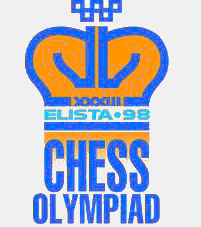
Back أولمبياد الشطرنج ال33 Arabic Olimpíada d'escacs de 1998 Catalan Schacholympiade 1998 German 33-a Ŝakolimpiko Esperanto Olympiade d'échecs de 1998 French אולימפיאדת השחמט 1998 HE Šahovska olimpijada 1998. Croatian 1998-as sakkolimpia Hungarian Շախմատային օլիմպիադա 1998 Armenian Olimpiadi degli scacchi del 1998 Italian


The 33rd Chess Olympiad (33-я Шахматная олимпиада, 33-ya Shakhmatnaya olimpiada; Kalmyk: 33-гче Шатрин олимпиад, 33-gçe Şatrin olimpiad), organized by FIDE and comprising an open[1] and a women's tournament, took place between September 26 and October 13, 1998, in Elista, Kalmykia, Russia. There were 110 teams in the open event and 72 in the women's event.
The Olympiad was the first international chess event to be held at Chess City. Construction of the complex was not complete by the start of the tournament, and some FIDE members were concerned that the facilities would not be ready in time, including the airport, telephone system, player housing, and the "Chess Palace" to be used as the main playing hall.
Reported human rights abuses by FIDE and Kalmykia president Kirsan Ilyumzhinov led to calls for a boycott from Valery Borshchev, a member of the Duma. The British government did not call for a boycott but confirmed "reliable reports of human rights problems" and suggested that Kalmykian authorities might use publicity from Olympiad participation by foreign teams for its own purposes.[2] Three nations were signed up but chose to stay away: Denmark, Norway, and Slovakia.
The opening ceremony took place as scheduled, but the Chess Palace was still covered in scaffolding and was missing many windows. The first round was delayed, one free day was eliminated, and the tournament was shortened to 13 rounds from the planned 14. The organizers worked around the clock and playing conditions improved as the tournament progressed, although the main playing hall was not properly heated. Living conditions, food and drink, and telephone service were generally reported to be acceptable.[3][4]
Both tournament sections were officiated by International Arbiter Geurt Gijssen (Netherlands). Teams were paired across the 13 rounds of competition according to the Swiss system. The open division was played over four boards per round, whilst the women's was played over three. In the event of a draw, the tie-break was decided by 1. the Buchholz system; and 2. match points.
The time control for each game permitted each player 100 minutes to make their first 40 moves, then an additional 50 minutes to make the next 20 moves, and then 10 minutes to finish the game, with an additional 30 seconds devolving on each player after each move, beginning with the first.
In addition to the overall medal winners, the teams were divided into seeding groups, with the top finishers in each group receiving special prizes.
- ^ Although commonly referred to as the men's division, this section is open to both male and female players.
- ^ "The Week in Chess 202". theweekinchess.com. Retrieved 2016-11-04.
- ^ "The Week in Chess 203". theweekinchess.com. Retrieved 2016-11-04.
- ^ "The Week in Chess 204". theweekinchess.com. Retrieved 2016-11-04.